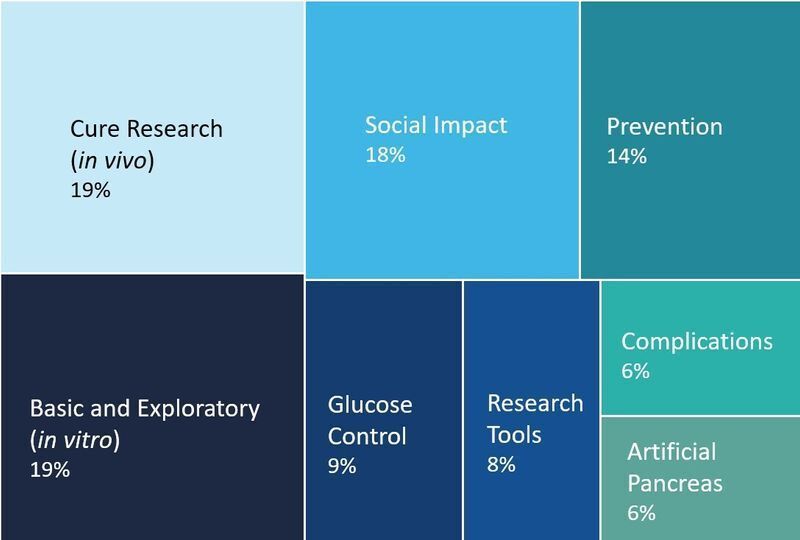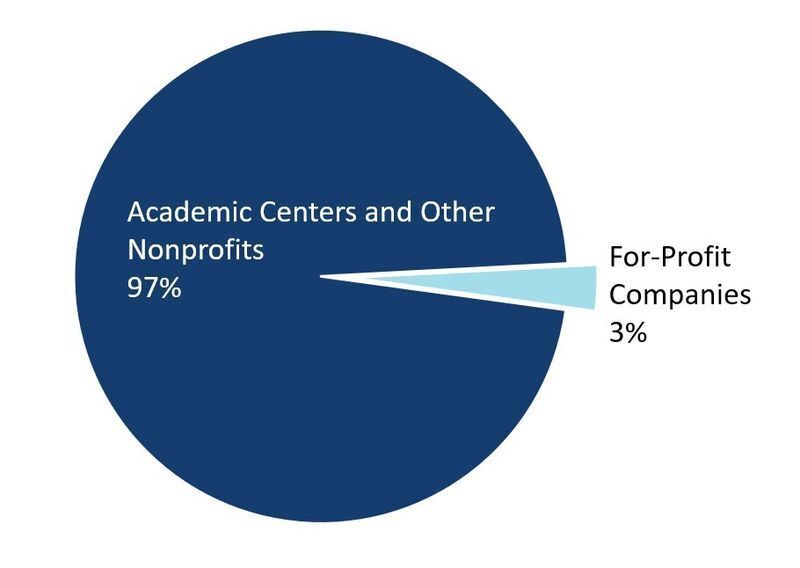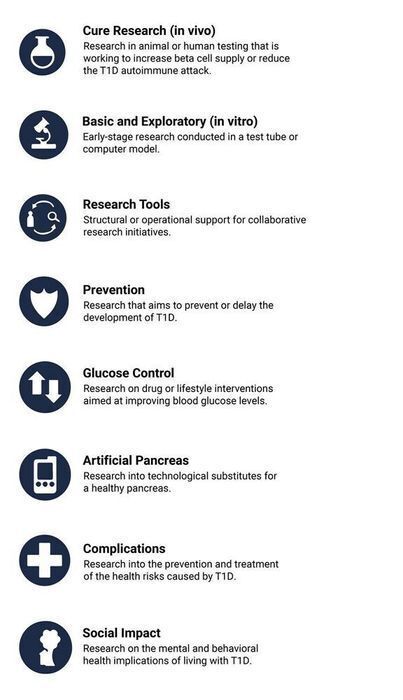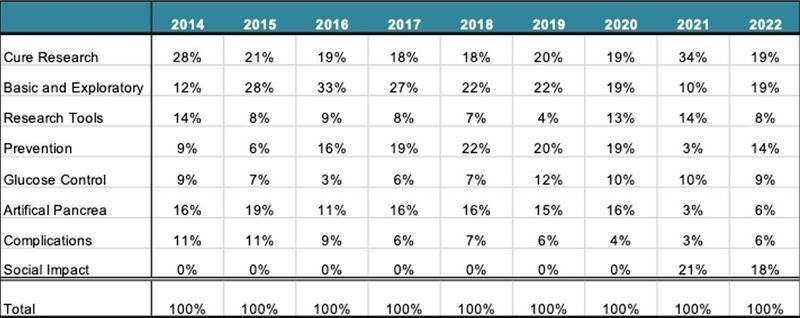September 6, 2023
This is the 12th annual report reviewing the research grant funding by the Juvenile Diabetes Research Foundation (JDRF). JDRF is a powerhouse in the type 1 diabetes (T1D) landscape, providing tens of millions of dollars annually for vital research grants. No other nonprofit organization is in a better position to fund Practical Cure research for T1D.
This report reviews research grants fulfilled or contracted during the 2022 Fiscal Year (July 1, 2021–June 30, 2022). During FY22, JDRF had 390 active grants and made 158 new research grants, totaling $73 million. An additional $24 million was also committed during this time.
JDCA staff reviewed each research grant individually and categorized them by area. Analyzing the new grants made during FY22 provides insight into how the JDRF uses its research budget, and which areas of research are receiving the highest or lowest priority.
Appendix A is an infographic with category definitions for reference. These categories are somewhat different than the ones used by the JDRF. We make this distinction in order to zero in on the projects that may provide a pathway to a Functional/Practical Cure and have progressed to testing in animals and/or humans (as opposed to computer simulations or test tube models).
All JDRF grants are available for the public to view in the grant center, which can be found in the Helpful Links section at the end of this report, containing our list of sources. This public database is an excellent source of information for the T1D community and is a strong example of information transparency.
FY22 is also noteworthy because it marks the first year after the COVID disruption. During the prior year of FY21, JDRF took a cautionary position due to COVID-19 and funded only $29M of research grants, by far the lowest level since we have been tracking the data. FY22 marks a significant return to supporting research grants. However, in our opinion, it continues to underfund and underprioritize cure research grants.
Research Grant Priorities
Chart 1: JDRF FY2022 Research Grant Expenditure by JDCA Category (100% = $73 million)

Cure Research and Basic Exploratory: A Tie for Top Priority
The two largest grant categories in FY22 are cure research (in vivo) and basic/exploratory research, each receiving 19% of the annual grant budget (see chart 1). For cure research, this percentage is similar to most years before COVID but is much lower than last year when it accounted for 34% of the annual research budget, making it the clear #1 priority (see Appendix B). In last year’s review, we expressed hope that this priority level and percentage would be maintained in future years, as cure research takes precedence for donors. But, as we see in FY22, it did not continue as the clear, single-minded primary focus.
That said, during the same time frame, the amount going to cure research has increased from $10M to about $18M, gaining from the growth of the total grant budget. Basic and exploratory research—which has not yet progressed into animal or human trials—grew from 10% to 19% in FY22, and from $3 million to $19 million, suggesting a rising increase in importance.
No Practical/Functional Cure Projects
None of the projects funded can be described as a Practical/Functional Cure for T1D. None of the projects were in or about to enter human trials with both a cell supply and a cell protection solution.
Social Impact Cause Funding Sees a Huge Uplift and Takes Third Position
Social impact grants emerged as a major priority in FY21 and continue as such in FY22. Prior to FY21, JDRF made very few social impact grants. The shift in FY21 is a strategic one. It was the first time that JDRF leadership elevated social impact to a high level of importance, providing large grants to improve care in developing countries. What was not a priority just a few years ago accounted for 21% of the research grant budget in FY21 and 18% of the budget in FY22.
The largest single grant given in FY22 falls under social impact—$6 million given to the nonprofit Civica to manufacture affordable insulin. Five of the top ten largest grants given in FY22 were dedicated to social impact, representing roughly 15% of the total dollar value of all grants given. The social impact topics addressed with those grants include access to care in countries with limited resources and mental health issues, including depression and eating disorders related to T1D.
Prevention Returns as a Priority in FY22
Grants funding prevention research rose to fourth priority in FY22, following a year with very few prevention grants. In FY22, prevention research grants utilized 14% of research fund dollars compared to 3% in the prior year. These grants fund research that focuses on early identification and solutions that prevent the disease from developing before it starts, such as a vaccine or other pre-emptive genetic modification.
Nonprofit versus For-Profit Grants
Chart 2: Nonprofit Versus For-Profit: % of Allocated Grant Dollars

The majority of grants given by the JDRF are to nonprofit or academic institutions. In FY22, the JDRF made five commercial grants, accounting for 3% of the total dollar allocation; 97% was given to nonprofit or academic entities.
In prior years, the JDRF allocated between 5% and 10% of its dollar allocations to commercial organizations. However, as the JDRF T1D Fund has grown and developed, the number of commercial grants given by the JDRF has decreased.
It is worth noting that the JDRF T1D Fund, which we will cover separately in the months ahead, invests in for-profit organizations in return for ownership equity. Therefore, if the invested company is a success, the Fund receives its fair portion of the profit. The JDRF, on the other hand, only makes grants—gifts toward the JDRF mission with no expectation of equity or claim on future revenue should the grant result in a commercially successful product.
COVID-Era Cash Build Up = Opportunity for a Big Boost to Cure Research
During COVID, the JDRF built up a historically large pool of unspent dollars. JDRF tightened and reduced expenses during COVID, as did many companies, but simultaneously continued to generate strong revenue. This resulted in a sizeable $132 million cash build-up—by far the largest since the JDCA has been tracking T1D nonprofits.
What Will the JDRF Do with This Money in the Years Ahead? Accelerate Cure Research?
This is an exciting and pivotal juncture. JDRF leadership has a once-in-a-generation opportunity to review, rethink, and reset their research agenda. During the Spring of 2023, JDRF executives indicated that research grants would cross the $100 million mark per annum in 2023, making it the first time since 2013 they reached that level. We hope that cure research—particularly research that directly leads to a Practical/Functional Cure and prioritizes work that is imminent or in human trials—can be given reinforced precedence and a heightened focus.
Appendix A: Research Grant Category Definitions

Appendix B: JDRF Research Grant Spending Historic Trends by Category (as a percent of total grant funding)

Helpful Links:
JDRF Audited Financial Statements FY22
JDRF Grant Center
JDRF 2022: "How Money was Earned and Used" (JDCA report)
